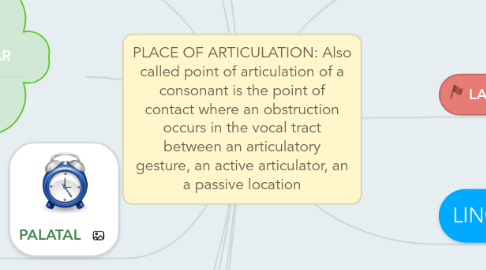PLACE OF ARTICULATION: Also called point of articulation of a consonant is the point of contact where an obstruction occurs in the vocal tract between an articulatory gesture, an active articulator, an a passive location
저자: marlon guerrero

1. DENTAL
1.1. Some languages have dental consonants where only the tongue and the teeth are used.[θ] and [ð]. EXAMPLE: this- these
2. ALVEOLAR
2.1. The point of articulation of alveolar consonants is situated near the alveolar ridge which is the area lying between the upper front teeth and the palate. EXAMPLE: tow and sap
3. PALATO-ALVEOLAR
3.1. Palato-alveolars occur slightly deeper in the mouth than alveolars. EXAMPLE: sheep
4. ALVEOLO-PALATAL
4.1. This is where it gets trickier because it's becoming more and more difficult to feel areas in your mouth that are that deep and also because alveolo-palatals are not present in Standard American English
5. PALATAL
5.1. We are now getting to a depth in the mouth where portions like the back of the tongue are starting to be used to produce sounds Example; YET
6. VELAR
6.1. There are a few velars in English, so it should be pretty straightforward to learn what their point of articulation is EXAMPLE: king
7. UVULAR
7.1. A little deeper in the mouth, the uvula is found (the little thing that's dangling from the top in the back of the mouth), which is used for uvular consonants
8. PHARYNGEAL AND EPIGLOTTAL
8.1. We now proceed even deeper in the vocal tract and reach a point where only the root of the tongue reaches, at least in normal cases.
9. GLOTTAL
9.1. The glottis is even deeper than the pharynx and epiglottis in the throat. You can see where glottal consonants are produced here EXAMPLE; happy, heat
10. BILABIAL
10.1. Bilabials are consonant sounds produced by using both lips together. EXAMPLE: /p/ voiceless; pot, happy. /b/ voiced; ball, rub. /m/ nasal; mask, calm. /w/ glide; wish
11. LABIODENTAL
11.1. Labiodentals are also pretty straightforward; they are articulated by using both the lower lip and the upper front teeth. EXAMPLE: /f/ voiceless; food, thief. /v/; above, waiver
12. LINGUOLABIAL
12.1. Linguolabials are articulated by using both the tongue and the upper lip. EXAMPLE; [θ] VOICELESS; thing, with and [ð].VOICED; that, smooth


